**Editors note: This blog was originally published on 24th July 2018, with all details correct at the time of publication. The dispute between UKTV and Virgin Media has now been resolved, with an announcement on 11th August 2018 stating the two had reached a ‘long term agreement’ reinstating all of UKTV’s channels and services to Virgin Media.
Breakups – we’ve all been through them. The boyfriend who refused to wash his socks, the girlfriend who lost your cat, or the friend you realised you actually have nothing in common with. Accusations thrown around, harsh words said in the moment. Sound familiar? I thought as much. So, let’s all agree we can relate as we grab our boxes of popcorn and watch the spat currently playing out between UKTV and Virgin Media in the very public arena of Twitter.
Now, I’m not here to comment on who’s right or wrong in what is clearly a complicated negotiation of contracts and something I know nothing about. Instead, I’m going to happily sit here in my comfort zone and analyse who’s doing the better job of managing their reputation and communicating with their audience. (TLDR*? It’s UKTV)
So, before we begin, I’ll catch you up on what the issue is here. Around four million Virgin Media households have lost access to 10 UKTV channels following a dispute over fees. Virgin Media have said that UKTV are “holding back channels” and asking for “inflated sums of money for its paid channels like Gold.” UKTV have said that Virgin Media want to “drastically cut” the fee they pay for their channels and UKTV just can’t afford to take the hit. Got it? Good– let’s go!
The news first broke on 19thJuly and since then UKTV have tweeted about it (including retweets, not including replies) 19 times, whilst Virgin Media are trailing behind with a slightly less impressive 3**. Now, whilst I’ll usually champion the whole “quality over quantity” approach, in this situation, with such a major change to the package they pay for, Virgin’s customers want to be kept updated with conversation about what’s going on. They want to know that this issue is at the forefront of Virgin Media’s minds. And, most importantly, they want to feel as though something is being done about it. 19 tweets say, we’re here and we’re concerned, three tweets in the space of 6 days doesn’t really cut the mustard.
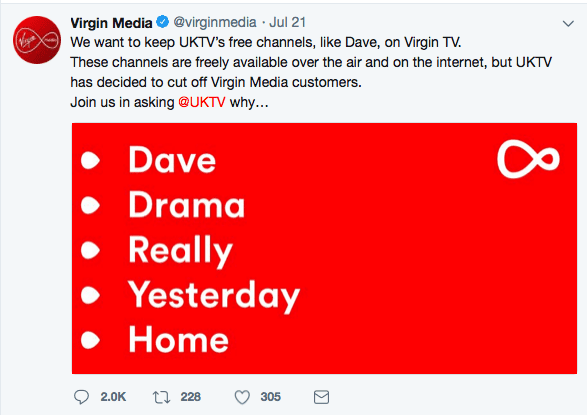
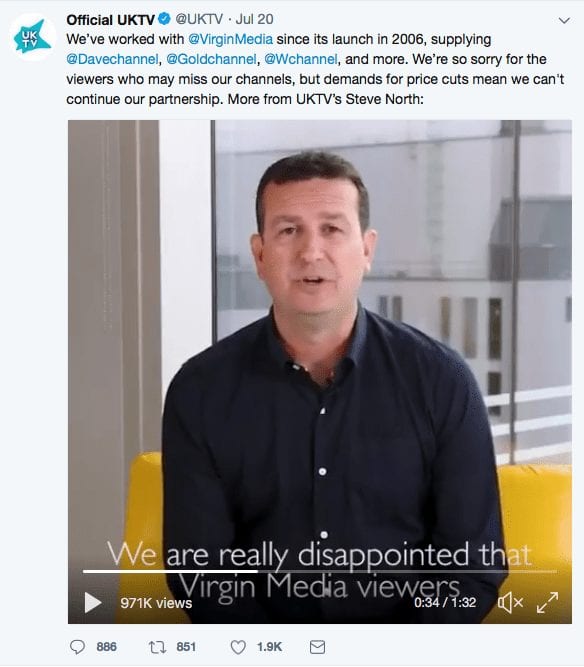
As with the tone of most arguments, it’s all a little “he said, she said.” But if we compare the tweets being put out by each account, UKTV have done a great job of putting Virgin’s customers first, whilst explaining their own point of view. Virgin Media on the other hand are taking an approach more concerned with directing the blame away from themselves and trying to instigate a manhunt for UKTV. Not very classy. It’s worth noting that at the time of writing, Virgin Media haven’t issued any tweets about why they’re asking for more money from UKTV.
Whilst we’re here, I’d like to do a quick shout out here to UKTV’s use of video throughout all of this. Great use of video is so important in social media and has been for a long time. Platforms like Twitter want to show it, audiences want to engage with it and it’s way more personal than a press release.
Whilst Virgin Media have posted a video, it’s a recording of a BBC News clip showing their Chief Digital Entertainment Officer giving his statement, retweeted from the Virgin Media Corporate Twitter account which isn’t even remotely consumer facing. Come on guys, let’s try a little harder…like our friends over at UKTV. They’ve issued two of their own pieces of video, presented by their General Manager for Comedy and Entertainment channels, straight to camera so he’s directly addressing the audience, making them feel acknowledged and heard. And the content hits the mark too, clearly explaining UKTV’s point of view, recognising Virgin Media customers’ frustrations and apologising. Whilst this is turning into a bit of a love letter to UKTV, I will give credit to both brands here – their choice of spokesperson is spot on.
Choosing someone who is clearly in charge and is directly involved in the situation is important as it gives them authority and credibility.
UKTV Tweet:
We’ve worked with @virginmedia since its launch in 2006. We’re so sorry for any viewers who are missing our channels, but we couldn’t afford to take such a huge pay cut. We are still available on @SkyUK, @BT_UK, @FreeviewTV, @Freesat_TV, @TalkTalkTV and @NOWTV. pic.twitter.com/FRnghOs72u
— Official UKTV (@UKTV) July 21, 2018
Virgin media Tweet:
As we’ve repeatedly said: We stand ready to put UKTV’s free channels, like Dave, back on air for our customers. These channels are funded by advertising and are free everywhere else. It’s time for @UKTV to #saveDave.
*News clip from @BBCNews pic.twitter.com/9bL9guWVUS
— Virgin Media Corporate (@VirginMediaCorp) July 23, 2018
When it comes to engaging with their audience, in this situation it’s incredibly important. Not only to provide them with good service, but to manage your reputation and influence how customers perceive your brand. To their credit, Virgin Media have done a great job of responding to frustrated customers and haven’t just ignored their complaints. On the other hand, as we can see in the examples below, a lot of their replies are obviously coming from a batch of stock responses.

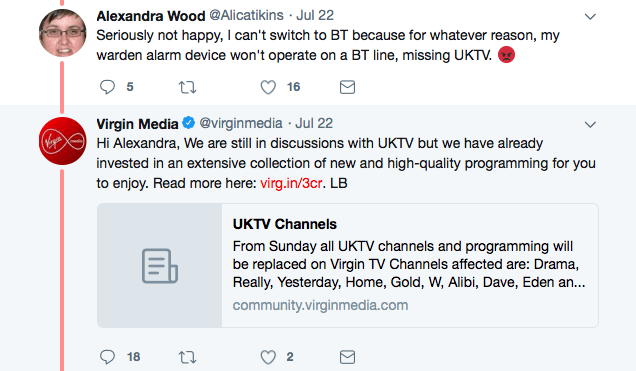

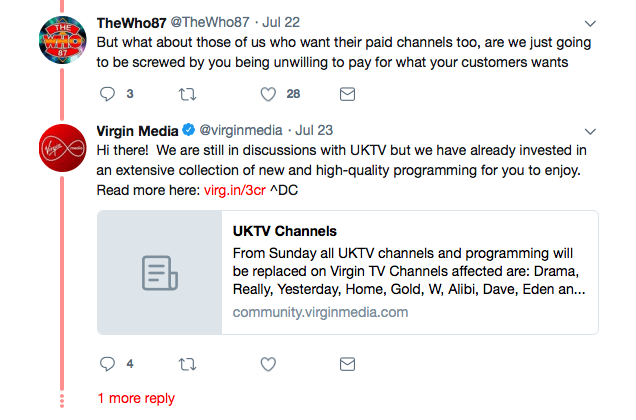
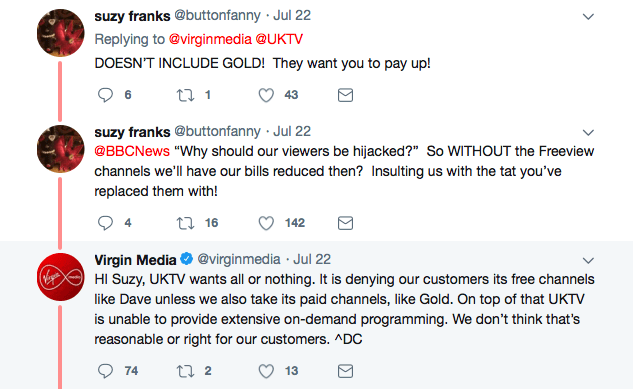
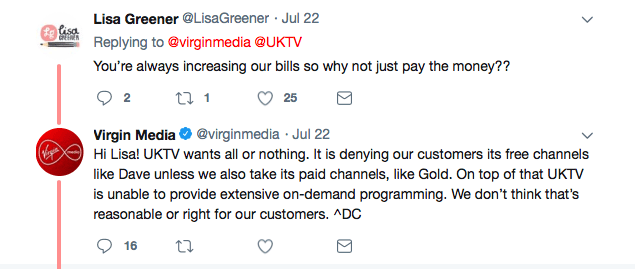
Now, don’t get me wrong – stock responses can be very useful, but they start to become problematic when responses are required in such high volume. Although very handy for your workload, they do come across as robotic and lacking in personal touch.
And it doesn’t go unnoticed:
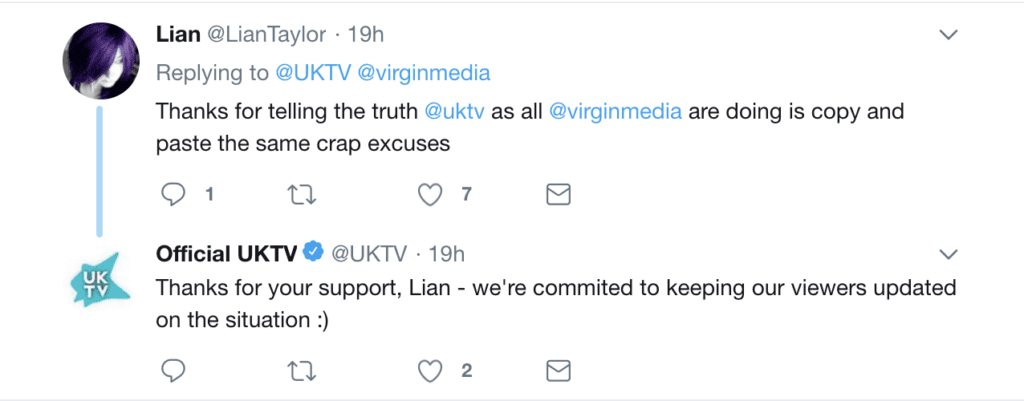
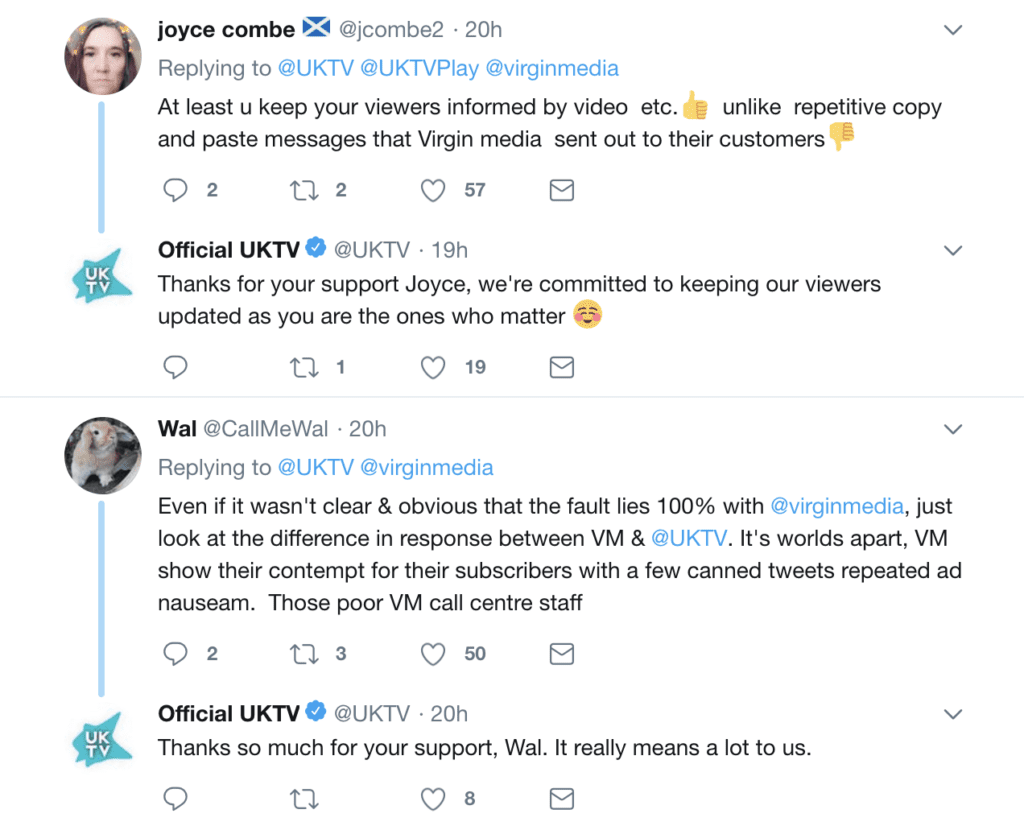
So, this blog is getting a little long, so I’ll wrap things up. What can we all learn from this? It’s not that Virgin Media have done anything outstandingly bad here, they haven’t.
But UKTV have done a much better job at engaging with their audience and promoting themselves as a brand who put their viewers first.
My main takeaways are:
- Keep those stakeholders primarily affected, such as customers, at the forefront of your communications
- Engage your audience with meaningful conversation
- Use engaging and informative video to convey your messages
Hannah
*Psst! In case you’re not into internet abbreviations, TLDR = Too long, didn’t read, although that’s probably not relevant given the length of this one!
**Accurate at the time of publishing.